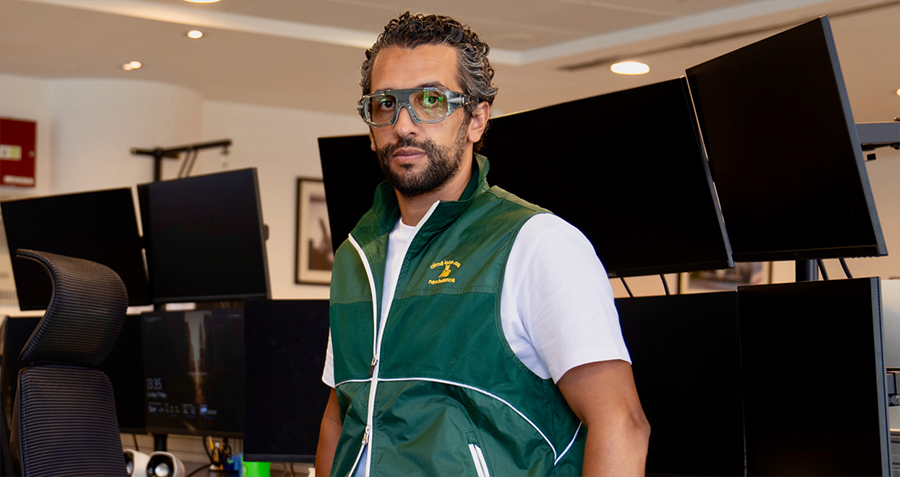Linda Hill, author of Collective Genius, believes leaders should create a context in which people are willing and able to innovate.
Remember Sully, the lovable blue and purple monster in the movies Monsters, Inc. and Monsters University, who spent much of his time trying to learn how to scare human children? His antics have made audiences across the world—and perhaps you—laugh. But did you know how much effort went into making Sully’s blue fur? A lot. And this is not just counting the approximately 5.4 million hairs in Sully’s fur in Monsters University. A lot went into portraying the fur realistically: moving strands of hair as Sully walked, getting shadows of the hair to look right. The Sully you got to see and love was not the result of one man’s efforts—but the ‘collective genius’ of several animators at Pixar, as Harvard Business School professor Linda Hill would probably put it.
In a recent book titled Collective Genius (co-authored with Greg Brandeau, Emily Truelove and Kent Lineback), Hill, a renowned leadership expert, demolishes the myth of the ‘solo genius’ who has an ‘aha moment’ leading to breakthrough innovation. Instead, she argues, innovation is a collaborative effort, featuring many individuals’ contributions, several missteps, false starts and combinations of several ideas.
In this interview she explains the role leaders should play in the innovation process.
Q. You say that innovation is not about solo genius, but it’s about collective genius. This flies in the face of a lot of management thinking.
A. I began to realize that the research on innovation was very separate from the research on leadership. So even though we knew about how to innovate, we didn’t talk about what do you as a leader need to do so that your organization can do these things.
When I began to explore that connection, and talk to leaders who led organizations that were very innovative, one of them said, “I don’t read books on leadership because when I read them I begin to feel bad, because the book says on page 1 if you’re a really good leader, you better have a vision of where you’re going. But if you’re trying to do something that’s breakthrough, you don’t have a vision, you don’t necessarily even know how you’re going to get there. So I decided that these books weren’t relevant to my experience.” That was very unsettling because I did a lot of teaching about vision and visionary leadership. When I began to see the lack of connection plus these very innovative leaders [who] didn’t identify with that, I thought I better study this.
All the people that I studied were, in fact, visionaries. They just don’t define their leadership role as being visionary. They’re really in the place where visionary leadership is very much about leading change, as John Kotter and Warren Bennis have thought of.
Q. Is the idea of the visionary leader overrated?
A. It’s not overrated when it comes to change. Since we need to innovate, which is a different process, we need to do things that are breakthrough. I don’t think I’d say it was overrated because many, many companies need to be transformed and need change agents. We can’t hope that, as someone writes, lightning is going to strike twice. There are geniuses out there like Steve Jobs, who can create businesses. But I study Pixar, Steve Jobs’ other company [apart from Apple], and they are deep believers in collective genius, so I think also the image of what he believes about leadership is not accurate. Because, you look at this other company that he created and that operated [differently].
The evidence is that millennials are different. This new generation does not want to follow. As one of the leaders said, “If I said, I’m the visionary, you follow me, they won’t follow me.” They don’t want to follow you to the future; they want to co-create the future with you. The idea of collective genius is just to capture the imagination of a lot of young people, because they want to be able to co-create, [and] not be a follower, in the traditional sense.
Q. One of the most telling lines in some of the talks you’ve given, is that leaders set the stage, but they don’t perform on it. What is the role of the leader in the innovation process?
A. So this is the challenge. All of these leaders can perform. And you would want them to perform, because they are so good and they are visionaries in some ways. But they understand that if they perform all the time, first, they’re going to take up all the space from other people who have their own talent that they can bring to the table.
If you believe that everybody has a slice of genius, everybody in your organization has something to offer, your role as a leader is to create the context in which people will be willing and able to do innovative problem solving. Look at the research on solo geniuses, who have supposedly ‘aha’ moments…. Howard Gardner (a famous developmental psychologist), who looks a lot at the creativity of artists like Picasso, said to me, “I don’t know that I emphasized as much as I could have the social context that was required for that artist to be effective and how much that artist actually interacted with other artists to make his or her work so excellent.” So we actually have always known on some level that there is this social process that happens, you need to have that stage setting, even for the genius to get it done.
If you believe you have diverse slices of genius in your organization, you have to bring those slices together to do a process of innovative problem solving. And there are three things that we’ve known for a long time about innovation. Most innovation is the result of collaborative work, of diverse individuals with different points of view and different expertise.
The second thing is that most innovation is the result of discoveries from learning. You don’t plan your way to an innovation, you act your way. It’s not surprising that so many individuals try to learn how to do design thinking, because that’s about discovery driven learning: you work with your customer, prototype, learn rapidly, fail fast, etc. Almost all innovations [have] lots of missteps, false starts, mistakes.
And then the final thing we know is that most innovations are not completely new: using the combination of old ideas, [or] a reconfiguration of some old ideas, to solve a new problem or address a new opportunity. So you have to have a way of decision making that you actually end up being able to combine ideas, as opposed to having one side win and one side lose. Those are Roger Martin’s ideas about opposable thinking. All these pieces of the puzzle have been written about. Because we were on the ground watching people do stuff, we were able to combine it in a more integrated way. So we’ve always known that’s true about innovation, yet there’s this myth of this solo genius having these ‘aha’ moments: there’s no research that supports that.
Q. Can you give me an example of a company that does this really well?
A. My favorite example is Pixar because founder Ed Catmull is one of the finest leaders I’ve ever met. He also was very involved in the turnaround of Disney Animation. He knows how to build from scratch and also transform. [At] Pixar, they say it’s like everybody has a slice of genius, and the art of leadership is to create a world to which people want to belong. So they understand the importance, the power of a culture you build, and the capabilities that will allow those people to really share, use, refine and learn their own slice of genius, so they can contribute to an organization whose purpose they really care about.
In our work on winning talent and emerging markets, we found that talented, passionate people want a couple of things: they want the opportunity to learn with people that they respect and enjoy, so they can contribute, they can actually have an impact on an organization whose purpose they care about. On any dimension you’d have to say that Pixar is one of the most successful studios ever, financially, in terms of artistic achievement, technical achievement…
They understand the importance of community. A lot of the people at Pixar who are at the heart of it have been together for over 20 years. It actually took them 20 years to create the first full-length computer generated movie. We often forget how hard breakthrough innovation truly is. They continued to build on that. They’ve done 15 movies, and they’re iconic, most of them. They’ve changed how children and families are entertained, and they’ve changed the whole industry.
Q. Good leaders need to create communities with a sense of shared purpose. How can everyone, with differing personalities and ways of thinking, be aligned around the shared purpose and be made to believe in it?
A. That is one of the hardest pieces of the puzzle, and one of the reasons why I have the deepest respect for Ed is because Pixar has gone through a lot. It’s been acquired by Disney, the company has scaled, so it’s not like he’s just had to deal with it in one context… As you get larger and more diverse, it is harder to build that collective sense of identity. That is one of the deep challenges that large global companies have.
I was very impressed when one of the foremost CEOs of IBM understood, as he put it, “I can’t provide a vision for this company that will really align us because we’re too big and too diverse, so any vision I come up with will not really guide you. I’d rather make sure we can clarify our values, that we all agree on what we value, fundamentally who we are.” A number of years ago, he asked one of the most prestigious groups at IBM to create a way for 200,000-300,000 people to have a real-time live conversation with each other. They had what they called a values jam. The CEO said, “These are the values of IBM, this is why this company was founded. Are they still relevant today? If so, describe examples, or what doesn’t work.” After they finished the values jam, they all agreed, and the CEO weighed in as well. In the end he said, “Okay, we’ve had this conversation, we’ve heard all of this, and now here are the values of IBM. If you don’t agree with these values, leave, you don’t belong here, you’re not going to be happy, we’re not going to be able to trust and respect you.”
Q. Different kinds of people make up an organization: some can be called doers, others thinkers; some lead, others simply follow. How should leaders really step in and use these different kinds of people, or as you say, in some cases minimize differences, or amplify them, and why?
A. Relatively speaking, in most organizations where you see a lot of innovations or teams, they do hire carefully. A leader describes that she hired more for attitude and values, than competencies. Frankly the world is changing so much you don’t really know what skills and competencies you’re going to need in the long haul. So one of [the things] she was looking for was the people [who] wanted to learn, expand, [be] curious… We all have different strengths and passions. What you’re trying to do in the ideal world is allow people to be authentic and play out who they want to be.
So you as a leader need to at first be open to recognizing what the talents and passions of people are and let them let you know what those are. That means providing enough psychological safety that people aren’t worried about job security, that people aren’t going to not speak the truth to you about what they like to do and how they like to do it. When you build these kinds of cultures, people will tell you what they don’t know. Once you have people you can trust, who are open to telling you what they don’t know, and on the other hand, are looking for opportunities to be stretched…, then your job as a leader… is stage-setting—creating the right culture and those capabilities.
A part of stage-setting is helping those people identify what they are good at and what they should do. You want to encourage people to be able to play out as much as possible what they are good at, what they want to do, help them understand why it’s worth broadening themselves, because they actually have that curiosity to do that, and provide them with the experiences they need to do that. In those roles sometimes you as a leader are going to be very top-down.
Vineet Nayar (former CEO of HCL) says, “Sometimes I use just plain brute force to get done what needs to get done.” So creating collective genius is not about abdicating responsibility or being passive: they’re very actively in the game, shaping the context, working with the people: they’re all pretty hands on. But they understand that balance between when you need to intervene and step in, and when you need to step out. In the book we talk about these paradoxes that are at the heart of innovation, and what we’re always doing on a daily basis is calibrating, or recalibrating: has it been going on long enough, is it too chaotic, do we need a little bit more urgency, do I need to step in to make sure that we actually harness our slices of genius and make them into something that’s collective?
There’s …[a] paradox: one side [is about] how you unleash people’s talents, thoughts and passions, and the other side is about how you harness them. As a leader, an innovation has to be both new and useful: if it’s just new, it’s creative, but it’s not an innovation because it’s not useful. As a leader what you see is interactions are constantly calibrating between is it time to unleash; is it time to pull them together?
Q. You’ve studied a number of fairly global companies which have people from different countries working together. Some of them might be coming from collectivist cultures; others from more individualist cultures. Does this cause a dissonance in the idea of collective genius?
A. All the research on different cultures and different countries is based on averages. The average leader from the US is more individualistic than the average leader from Japan. You can see it in individualistic cultures, people are much more resistant to these ideas. Millennials, to some extent, are more accepting of the argument.
I met a group of young entrepreneurs. Some were very worried about what I was saying because they wanted to be visionary leaders [like] Steve Jobs. They were thinking, “Well, wait a minute, I have a vision”. I think when you’re being an entrepreneur, it’s almost closer to leading change, to creating something new, [so] obviously there is some visionary leadership required. I said, “How long do you want your company to exist?” A lot of them don’t care: they’re building it and selling it. But I said, “If you want to build a sustained company, what’s it going to take? Is it going to be all about you? No! Think about it, what does it take to build sustainability? The right culture, the right capabilities, that’s all I’m saying, so focus on those matters as well, because that is going to determine whether you can do it time and again, and if you’re not just a one-trick pony.”
I find… other cultures [are much more comfortable with] collective ideas… and are very relieved that I’m talking that way. But when you have people who come from the two different cultures there can be these clashes. As a very senior country manager from India said to me: “It’s so tiring because you do all the work and in some ways you don’t get the credit, others end up shining.” When he was the star producer, he was the star. And now, when he’s the leader, he’s the manager, not the star, and that’s what is really admired in his company. I said, “Yeah, that’s one of the things about leadership, learning that you’re more of a stage-setter than a performer. If you’re performing all the time, chances are you haven’t set the right stage for everybody else, and you know your time and attention is not taken up by all the right things.” Accepting that changing role is going to be one of the things that keeps some people from not being able to build innovative organizations.
The other one that’s going to be hard for people is trying to build an organization where you believe everybody has a slice of genius. That is not to mean that everybody has equal slices: some people have much bigger slices than others. It’s very hard to lead the way I’ve described unless you fundamentally have a positive or an optimistic view about human nature and people’s capabilities. One of the things that people say about these leaders is that they’re described as being the most demanding boss a person has ever had, but also the most generous boss.
Q. A lot of companies from certain countries—China for instance— are very hierarchical, people are very respectful of authority, they don’t speak up to bosses, they don’t disagree. This would obviously have a bearing on the idea of collective genius. How should a leader really work around these issues?
A. In many of those cultures actually you can have this combination of hierarchy but also more collaborative approaches. We collected data from seven different countries, and some of them are very hierarchical. We did see common patterns in how the leaders thought about what their role was, but it was about creating the culture and the capabilities that I’ve described. But the actual tactics that they used varied.
One leader [in Singapore] said, “People will not even sit down: they will stand when I’m in the room because of the hierarchy. If I want to have a very serious conversation with an executive, I start the conversation when we’re on an airplane where we have to sit next to each other!” A Chinese executive that we studied never moved into his own office. He has a big corner office, but he still works outside the office in a very big cubicle. He said symbolically it’s very important that he’s never really moved into that office. But it would have been too unsettling to people if he didn’t have an office. These interesting tactics, a symbolic action often, send signals to people that it’s okay to be different towards me than you’re used to, or that your culture would tell you to be.



















